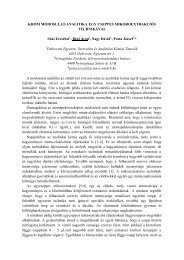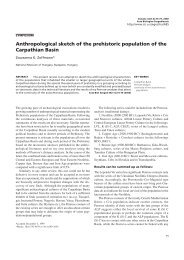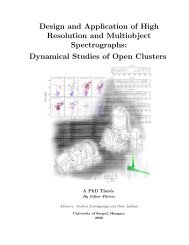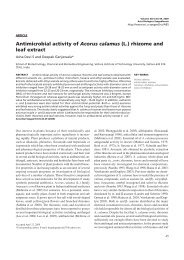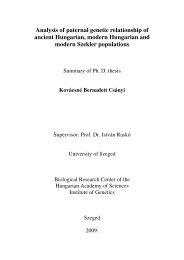principles of extraction and the extraction of semivolatile organics ...
principles of extraction and the extraction of semivolatile organics ...
principles of extraction and the extraction of semivolatile organics ...
You also want an ePaper? Increase the reach of your titles
YUMPU automatically turns print PDFs into web optimized ePapers that Google loves.
40 <strong>principles</strong> <strong>of</strong> <strong>extraction</strong><br />
Solubility<br />
Solubility is also used to estimate <strong>the</strong> Henry’s law constant [equation (2.4)].<br />
Solubility is <strong>the</strong> maximum amount <strong>of</strong> a chemical that can be dissolved into<br />
ano<strong>the</strong>r at a given temperature. Solubility can be determined experimentally<br />
or estimated from molecular structure [6,10–12].<br />
The Henry’s law constant, H, calculated from <strong>the</strong> ratio <strong>of</strong> vapor pressure<br />
<strong>and</strong> solubility [equation (2.4)] can be converted to <strong>the</strong> dimensionless Henry’s<br />
law constant, H 0 , [equation (2.3)] by <strong>the</strong> expression<br />
H 0 ¼ PvpðMWÞ<br />
0:062ST<br />
ð2:5Þ<br />
where Pvp is <strong>the</strong> vapor pressure in mmHg, MW <strong>the</strong> molecular weight, S <strong>the</strong><br />
water solubility in mg/L, T <strong>the</strong> temperature in Kelvin, <strong>and</strong> 0.062 is <strong>the</strong><br />
appropriate universal gas constant [9].<br />
For <strong>the</strong> analyst’s purposes, it is usually su‰cient to categorize <strong>the</strong> escaping<br />
tendency <strong>of</strong> <strong>the</strong> organic compound from a liquid to a gas as high,<br />
medium, or low. According to Henry’s law expressed as equation (2.4), estimating<br />
<strong>the</strong> volatilization tendency requires consideration <strong>of</strong> both <strong>the</strong> vapor<br />
pressure <strong>and</strong> <strong>the</strong> solubility <strong>of</strong> <strong>the</strong> organic solute. Ney [13] ranks vapor pressures<br />
as<br />
Low: 1 10 6 mmHg<br />
Medium: between 1 10 6 <strong>and</strong> 1 10 2 mmHg<br />
High: greater than 1 10 2 mmHg<br />
while ranking water solubilities as<br />
Low: less than 10 ppm<br />
Medium: between 10 <strong>and</strong> 1000 ppm<br />
High: greater than 1000 ppm<br />
However, note that in Ney’s approach, concentration expressed in parts per<br />
million (ppm) does not incorporate molecular weight. Therefore, it does not<br />
consider <strong>the</strong> identity or molecular character <strong>of</strong> <strong>the</strong> chemical.<br />
Rearranging equation (2.4) produces<br />
Pvp ¼ HS ð2:6Þ<br />
In this linear form, a plot (Figure 2.1) <strong>of</strong> vapor pressure (y-axis) versus solubility<br />
(x-axis) yields a slope representing <strong>the</strong> Henry’s law constant at values










